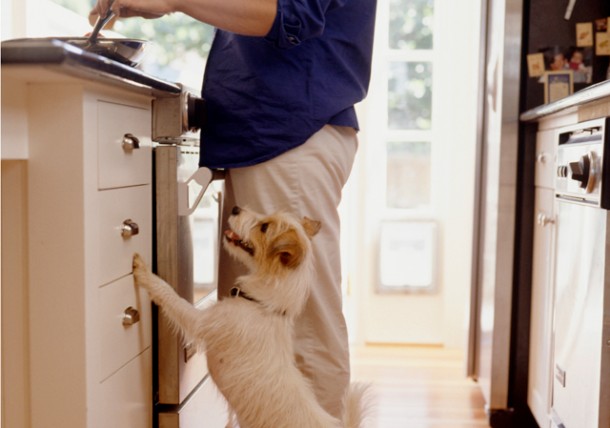Behavior Tips: Begging

My dogs can tell time. No kidding.
At 6 p.m. every night, the antics start. Buster starts happy-dancing around the room if I even look toward the food bowls. Marcy follows me from room to room, staring fixedly at me, willing me toward the crunchies. Tiny and polite whines escape from Abby as she lies quietly in the corner (she’s the shy one). All three dogs are showing different signs of the same behavior problem—begging.
What is Begging?
It doesn’t always mean sitting by the dinner table pawing at your leg and hoping for crumbs. Merriam-Webster’s online dictionary defines beg as “to ask (someone) in a very serious and emotional way for something needed or wanted very much.” Anything your pet does that constitutes an effort to get you to give them something (food, toys, attention, etc.) is begging. Sometimes it is adorable (like Abby’s ladylike whines, politely asking for dinner), while sometimes it can be irritating (“It is a little creepy to be stared at, Marcy!”) or even dangerous (“We’ve talked about this, Buster. If you happy-dance under my feet, I will unhappy-fall on you.”). There are two ways to approach the issue of begging and specifically for food. The first method works if you haven’t gotten a pet yet. The second method is for those of you already living with a beggar. In both cases, consistency is the key.
Stop Begging Tip #1
If you haven’t gotten a pet yet, this is the cardinal rule to live by: Do not reward behavior that you don’t want repeated. Begging is not something a pet has to learn; it only has to be reinforced—by you. If your pet begs and you reward them with the desired treat, toy or ear scratch, then you have reinforced to your pet that being a beggar works. They will then continue to beg. If you do not respond to their pleas, your pet will learn that they don’t work, and it will not become a habit. You must be consistent. It only takes one “success” for your pet to learn that begging works!
If you already live with a beggar, then you have two choices. You can work to stop it entirely, or you can live with it, but make sure if you choose the latter that it is healthy.
Stop Begging Tip #2
Putting a stop to a pet that begs is simple in theory and very hard in execution! The key, as mentioned above, is consistency. You simply stop responding to the begging behavior. It will take days, weeks, maybe months, but if you stay consistent, your pet will figure out that the beggar act is not getting the desired result and he will stop. As an added bonus, you can reinforce good behavior this way. For example, if you’re sitting on the couch eating popcorn and your pet begs for a piece, ignore him. If he goes away or stops the pleading behavior, when you finish your snack and head toward the kitchen with the bowl, call him over and reward with a piece of popcorn. That’s two reinforcements in one: “Good boy, for stopping begging, and good boy, for coming when I called you.”
Unhealthy Begging Behavior
If you can live with the pleading behavior but the treats are causing an unhealthy condition such as obesity, then your objective is to introduce healthy begging. Most people don’t consider treats part of a healthy diet, but they can be. The key is that the treats replace part of the diet, rather than being an addition to the regular diet. Measure your dog’s food; treats should make up less than 10 percent of your pet’s diet. If you are going to offer treats, decrease the regular meal serving accordingly. Then make healthy treat choices. Talk to your veterinarian or veterinary staff about the healthiest treat options.
Stop Begging Tip #3
One last tip: When it comes to food treats, the food itself isn’t the whole treat. The best part of the treat is that it came from your hands. Use your dog’s regular food for treats. They’ll still feel the love, but you will be showing it by keeping them healthy!


I never really thought that begging could be cured. i just thought it was something most dogs did!!!!! iset up the same scenario Jennifer mentioned with the popcorn to test the theory. I had to eat my popcorn very slowly (to give Woodrow time to get bored) but eventually he went to the other side of the room to pout! I gave it a few minutes and then dropped him some popcorn on the way to the kitchen as a reward! After a few nights of this he started sitting in the corner staring at me then graduated to laying down patiently!! Now if I can get him to stop chewing the furniture when im at work, I’d have it made!!! Thanks Jennifer!!! Bring on more!
Joshua Allen
Brenham, TX
I’m glad the technique worked for you, Joshua! This article has some great tips. Thanks for commenting!
-TexVetPets